It was spring in Barcelona when I took up a tour of the ‘Gaudi Trail’ in early April, which included the most creations by this great artist of Spain. From the most celebrated Gaudi’s La Sagrada Familia, I took a metro to Lesseps from where Park Guell is signposted. Aimed at holding a chapel, a cross on the hilltop, and houses for wealthies on the triangular plots, the park’s plan today is completely different as these intentions were left behind. The park is named so because of the patron of Gaudi named Eusebi Guell who planned it.
Nestled on the El Carmel hill in the Gracia area, Park Guell today is a big municipal garden complex of architectural elements rendering the attraction as the World Heritage site. The entire area is so dexterously planned to invite as well as maintain the calmness and peace that anybody would wish. The park entrance is flanked by two buildings that appear to be quite notably original with fabulous roofs and peculiar pinnacles. These two Hansel and Gretel lodges served as the concierge as well as the dwelling of the Park’s administrators. Although they go with the ambience, both appear to be subtle in this pleasure garden as compared to the extravagance of other Gaudi structures here. At the entrance, marvel at the Gaudi dragon fountain adorned in wonderful colored tiling. The main attractions here are the water fountains, serpentine bench, and the incomplete Hansel-and-Gretel-style dwellings.

Among all the highlights, the focus is always on its main terrace flanked by a lengthy bench taking a shape of a sea serpent. In this big open space, this bench was purposely made so to allow people to sit in groups and chat. This bench reflects one of the Gaudi characteristics, which is called trencadis referring to the cracked tile mosaics. The curves make up for a number of enclaves that ensure a good social atmosphere. Then, in the square, the collected rainwater flows down the columns and rises from the salamander’s mouth. The 96 columns actually make up for the market venue that was never erected leaving behind a plain structure. However, the acoustics are just superb forming the most suitable venue for concerts.
Below the so-called market exists the salamander – the three-tiered structure each of which representing a distinct element – nature in form of snake’s head, Catalonia in form the Catalan flag (featuring nationalistic art), and the different Masonic symbols atop whose representation was not known even to our guide. Around the Park Guell, you will see many roadways for servicing the planned homes made by Gaudí projecting from the vertical hillside or on the bridges. His structures here reverberates the natural styles – for example, the columns act as trunks of trees to support the branching vault beneath the roadway. Do also spot the big cross at the highest point in the park from where you can get a full vista of Barcelona as well as the bay. And yes, on a clear day, you can also have panorama of the main city along with the Sagrada Familia.
Just be a little observant and spot flying green birds such as pigeons and sparrows. In the palm trees, look for some monk parakeets. And yes, if you are lucky, you will also come across the hummingbird.
Before living, just also spend some time at a small house in the Park Guell that was the home of the great artist for some time. Today, it is a museum that houses interesting furniture that is obviously made by Gaudi. No matter where you go in the park, you will see that Gaudi has implemented many motifs of nature, Catalan nationalism, and religious theology.
Admission
Free, except for the museum
Timings
10 am to 6 pm in winter; extended to 9 pm in summer
Tip
Catching a metro will make you walk for 20 minutes of which the final 200 m is an ascent up a sheer hill. So, if you are not ready for this ascent, catch a taxi or bus.